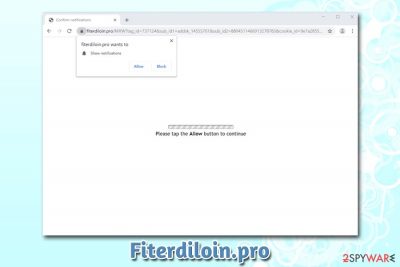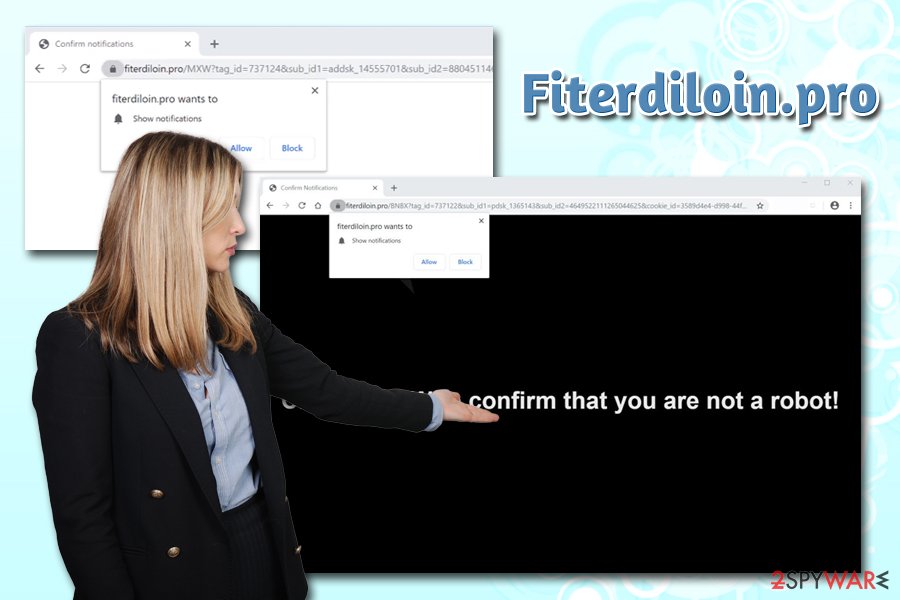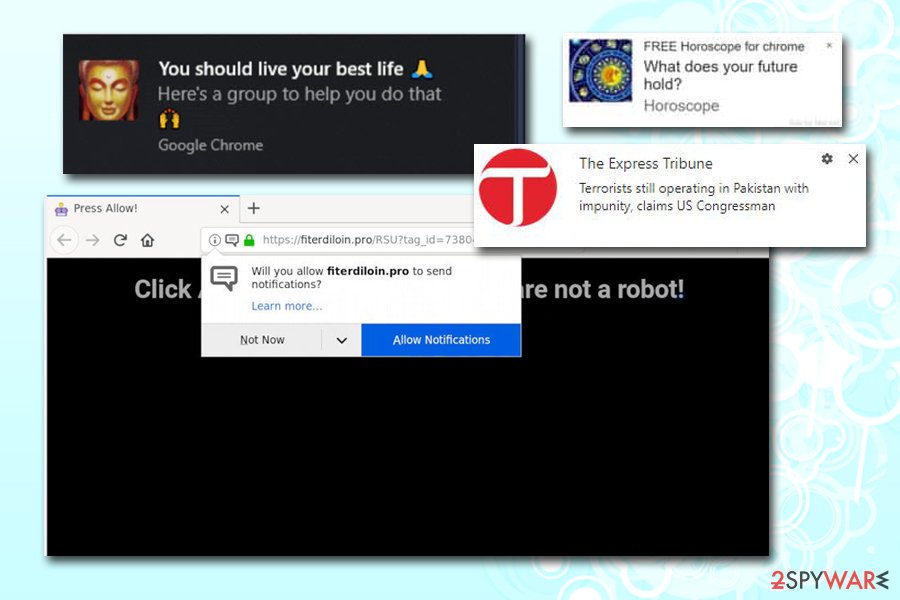Fiterdiloin.pro (Removal Guide) - Free Instructions
Fiterdiloin.pro Removal Guide
What is Fiterdiloin.pro?
Fiterdiloin.pro is a suspicious website that initiates intrusive pop-ups on users' desktop after using a social engineering trick

Fiterdiloin.pro is a domain that users might encounter either accidentally or if their machines are infected with adware[1] – a potentially unwanted program that specializes in showing offers, deals, coupons, banners, pop-ups, and other intrusive advertisements. The browser modifications affect all browsers, so users may see Fiterdiloin.pro redirects on Google Chrome, Safari, Internet Explorer, Mozilla Firefox, Opera, or any other installed browser.
| Name | Fiterdiloin.pro |
| Type | Push notification virus – users can encounter these unwanted pop-ups on multiple suspicious sites |
| Category | Adware |
| Associated risks | Adware can lead users to insecure sites that may ask to disclose personal data, download malicious software or subscribe to useless services (money loss) |
| Symptoms |
|
| Ways to stop desktop pop-ups | If you allowed Fiterdiloin.pro to show notifications, you could easily revert the change by following our detailed guide at the bottom section of this article for Google Chrome, MS Edge, Mozilla Firefox, and Safari |
| Stop unwanted browser behavior | If pop-up ads and other suspicious activity on your browser is persistent, it means that it is infected with adware, or even something more sinister. Therefore, we highly recommend scanning the computer with anti-malware software like FortectIntego, although you can also look for potentially unwanted apps manually (details below) |
Upon visiting the Fiterdiloin.pro site, users will be immediately asked to allow notifications to be shown:
Fiterdiloin.pro wants to
Show notifications
Allow Block
In most of the cases, they are promised the underlying content of the site, or a video that is about to be played. However, this is just a social engineering trick in order to make users allow the website to show ads directly on their desktops, even when the web browsers are non-operational. The behavior of the Fiterdiloin.pro virus often interrupts users' activities and disturbs them with unwanted commercial content.
If clicked, Fiterdiloin.pro ads may lead users to insecure sites that ask for personal information or show fraudulent claims about virus infections or outdated software. If you see frequent pop-ups from the site, you can stop them via the browser settings (we provide instructions below); however, if the unwanted redirects and ads are still bothering you, it means that your system needs to be cleaned from adware. Nevertheless, you should still aim to remove Fiterdiloin.pro ads as per our instructions below.
While adware is not considered to be a major security risk, security experts are urging users to be extremely wary, as these potentially unwanted programs might bring more nefarious threats to the computer, make them expose their personal data, or give away money for fake tech support services.

Besides, if Fiterdiloin.pro pop-ups and redirects are persistent, it means that third-parties are tracking your online behavior. The typically collected information includes:
- Browser cookies
- Sites visited
- Links clicked
- Duration of site visits
- Technical information
- IP address
- Geolocation, etc.
For full Fiterdiloin.pro removal, you should scan your machine with anti-malware software (we suggest FortectIntego) – it is the quickest solution, as it can eliminate all the unwanted components within minutes. Nevertheless, if you are a confident computer user, you could also try to get rid of the Fiterdiloin.pro virus yourself by following our manual instructions in the bottom section of this post.
You should pay close attention to the installation process of free applications downloaded from third-party sites
Potentially unwanted programs, while not a major security risk, should not be ignored. Security experts[2] always try to warn users about the potential dangers of adware, as it has been found in many malware campaigns. For example, some variants of STOP ransomware were distributed via adware bundles – Tro and Rumba to be precise.[3]
Software bundling is a technique used by various freeware/shareware developers worldwide. While it is not illegitimate, this distribution method often deliberately hides optional components behind pre-ticked boxes, fine print text, misleading buttons, and other deceptive ways. Because users are often in a rush during the installation process of applications, they often miss these points and end up with third-party software they never intended to install in the first place.

Thus, be attentive while installing programs from third-party sites – chances are that the installer you just opened includes potentially unwanted programs. In other cases, the app you are about to install is the PUP and will result in excessive advertising campaigns being launched on your computer. To avoid that, read up reviews online before installing anything you do not know much about. During the installation, always opt for Advanced/Custom installation mode, which would allow you to remove add-ons, media players, system optimizers, PDF converters, and other ad-supported software.
Stop Fiterdiloin.pro-related activities on your computer
If you enabled the Fiterdiloin.pro virus to show notifications on your device and seeing constant pop-ups on your desktop, you will have to visit the settings of each of the installed browsers and turn them off. Here's how:
Google Chrome
- Go to Menu and pick Settings
- Choose Advanced
- Under Privacy and security, select Site Settings
- Go to Notifications
- You should see Fiterdiloin.pro under the Allow section
- Pick More Actions and click on Block
Mozilla Firefox:
- Select Menu and then Options
- Click on Privacy & Security section and then pick Notifications
- Go to Settings –and you should see Fiterdiloin.pro
- Click on the the drop-down menu and click Block
- Finish with Save Changes
Safari:
- Click on Safari and select Preferences…
- Under Websites tab, click Notifications
- Pick Fiterdiloin.pro and then Deny
MS Edge:
- Click More and pick Settings
- Select View advanced settings and then Advanced
- Click on Manage permissions
- Find Fiterdiloin.pro entry and turn off notifications
These actions should stop desktop notifications from being shown. However, as we previously mentioned, Fiterdiloin.pro removal might require more work, as adware might be embedded in your system and redirecting you to dubious sites.
You can either scan your machine with anti-malware software or remove Fiterdiloin.pro manually as per our instructions below. While we do recommend using anti-virus software to check for all types of threats, the unwanted activity might seize as soon as you delete all the applications that you do not recognize.
You may remove virus damage with a help of FortectIntego. SpyHunter 5Combo Cleaner and Malwarebytes are recommended to detect potentially unwanted programs and viruses with all their files and registry entries that are related to them.
Getting rid of Fiterdiloin.pro. Follow these steps
Uninstall from Windows
If you want to remove adware from Windows operating systems, you need to check the installed program list via the Control Panel:
Instructions for Windows 10/8 machines:
- Enter Control Panel into Windows search box and hit Enter or click on the search result.
- Under Programs, select Uninstall a program.

- From the list, find the entry of the suspicious program.
- Right-click on the application and select Uninstall.
- If User Account Control shows up, click Yes.
- Wait till uninstallation process is complete and click OK.

If you are Windows 7/XP user, proceed with the following instructions:
- Click on Windows Start > Control Panel located on the right pane (if you are Windows XP user, click on Add/Remove Programs).
- In Control Panel, select Programs > Uninstall a program.

- Pick the unwanted application by clicking on it once.
- At the top, click Uninstall/Change.
- In the confirmation prompt, pick Yes.
- Click OK once the removal process is finished.
Delete from macOS
Macs can often get infected with adware. To remediate the situation, you should follow this guide:
Remove items from Applications folder:
- From the menu bar, select Go > Applications.
- In the Applications folder, look for all related entries.
- Click on the app and drag it to Trash (or right-click and pick Move to Trash)

To fully remove an unwanted app, you need to access Application Support, LaunchAgents, and LaunchDaemons folders and delete relevant files:
- Select Go > Go to Folder.
- Enter /Library/Application Support and click Go or press Enter.
- In the Application Support folder, look for any dubious entries and then delete them.
- Now enter /Library/LaunchAgents and /Library/LaunchDaemons folders the same way and terminate all the related .plist files.

Remove from Microsoft Edge
If Fiterdiloin.pro is one of many deceptive sites that your Internet Explorer is redirecting you to, you should reset it as explained below:
Delete unwanted extensions from MS Edge:
- Select Menu (three horizontal dots at the top-right of the browser window) and pick Extensions.
- From the list, pick the extension and click on the Gear icon.
- Click on Uninstall at the bottom.

Clear cookies and other browser data:
- Click on the Menu (three horizontal dots at the top-right of the browser window) and select Privacy & security.
- Under Clear browsing data, pick Choose what to clear.
- Select everything (apart from passwords, although you might want to include Media licenses as well, if applicable) and click on Clear.

Restore new tab and homepage settings:
- Click the menu icon and choose Settings.
- Then find On startup section.
- Click Disable if you found any suspicious domain.
Reset MS Edge if the above steps did not work:
- Press on Ctrl + Shift + Esc to open Task Manager.
- Click on More details arrow at the bottom of the window.
- Select Details tab.
- Now scroll down and locate every entry with Microsoft Edge name in it. Right-click on each of them and select End Task to stop MS Edge from running.

If this solution failed to help you, you need to use an advanced Edge reset method. Note that you need to backup your data before proceeding.
- Find the following folder on your computer: C:\\Users\\%username%\\AppData\\Local\\Packages\\Microsoft.MicrosoftEdge_8wekyb3d8bbwe.
- Press Ctrl + A on your keyboard to select all folders.
- Right-click on them and pick Delete

- Now right-click on the Start button and pick Windows PowerShell (Admin).
- When the new window opens, copy and paste the following command, and then press Enter:
Get-AppXPackage -AllUsers -Name Microsoft.MicrosoftEdge | Foreach {Add-AppxPackage -DisableDevelopmentMode -Register “$($_.InstallLocation)\\AppXManifest.xml” -Verbose

Instructions for Chromium-based Edge
Delete extensions from MS Edge (Chromium):
- Open Edge and click select Settings > Extensions.
- Delete unwanted extensions by clicking Remove.

Clear cache and site data:
- Click on Menu and go to Settings.
- Select Privacy, search and services.
- Under Clear browsing data, pick Choose what to clear.
- Under Time range, pick All time.
- Select Clear now.

Reset Chromium-based MS Edge:
- Click on Menu and select Settings.
- On the left side, pick Reset settings.
- Select Restore settings to their default values.
- Confirm with Reset.

Remove from Mozilla Firefox (FF)
Remove dangerous extensions:
- Open Mozilla Firefox browser and click on the Menu (three horizontal lines at the top-right of the window).
- Select Add-ons.
- In here, select unwanted plugin and click Remove.

Reset the homepage:
- Click three horizontal lines at the top right corner to open the menu.
- Choose Options.
- Under Home options, enter your preferred site that will open every time you newly open the Mozilla Firefox.
Clear cookies and site data:
- Click Menu and pick Settings.
- Go to Privacy & Security section.
- Scroll down to locate Cookies and Site Data.
- Click on Clear Data…
- Select Cookies and Site Data, as well as Cached Web Content and press Clear.

Reset Mozilla Firefox
If clearing the browser as explained above did not help, reset Mozilla Firefox:
- Open Mozilla Firefox browser and click the Menu.
- Go to Help and then choose Troubleshooting Information.

- Under Give Firefox a tune up section, click on Refresh Firefox…
- Once the pop-up shows up, confirm the action by pressing on Refresh Firefox.

Remove from Google Chrome
Delete malicious extensions from Google Chrome:
- Open Google Chrome, click on the Menu (three vertical dots at the top-right corner) and select More tools > Extensions.
- In the newly opened window, you will see all the installed extensions. Uninstall all the suspicious plugins that might be related to the unwanted program by clicking Remove.

Clear cache and web data from Chrome:
- Click on Menu and pick Settings.
- Under Privacy and security, select Clear browsing data.
- Select Browsing history, Cookies and other site data, as well as Cached images and files.
- Click Clear data.

Change your homepage:
- Click menu and choose Settings.
- Look for a suspicious site in the On startup section.
- Click on Open a specific or set of pages and click on three dots to find the Remove option.
Reset Google Chrome:
If the previous methods did not help you, reset Google Chrome to eliminate all the unwanted components:
- Click on Menu and select Settings.
- In the Settings, scroll down and click Advanced.
- Scroll down and locate Reset and clean up section.
- Now click Restore settings to their original defaults.
- Confirm with Reset settings.

Delete from Safari
Remove unwanted extensions from Safari:
- Click Safari > Preferences…
- In the new window, pick Extensions.
- Select the unwanted extension and select Uninstall.

Clear cookies and other website data from Safari:
- Click Safari > Clear History…
- From the drop-down menu under Clear, pick all history.
- Confirm with Clear History.

Reset Safari if the above-mentioned steps did not help you:
- Click Safari > Preferences…
- Go to Advanced tab.
- Tick the Show Develop menu in menu bar.
- From the menu bar, click Develop, and then select Empty Caches.

After uninstalling this potentially unwanted program (PUP) and fixing each of your web browsers, we recommend you to scan your PC system with a reputable anti-spyware. This will help you to get rid of Fiterdiloin.pro registry traces and will also identify related parasites or possible malware infections on your computer. For that you can use our top-rated malware remover: FortectIntego, SpyHunter 5Combo Cleaner or Malwarebytes.
How to prevent from getting adware
Access your website securely from any location
When you work on the domain, site, blog, or different project that requires constant management, content creation, or coding, you may need to connect to the server and content management service more often. The best solution for creating a tighter network could be a dedicated/fixed IP address.
If you make your IP address static and set to your device, you can connect to the CMS from any location and do not create any additional issues for the server or network manager that needs to monitor connections and activities. VPN software providers like Private Internet Access can help you with such settings and offer the option to control the online reputation and manage projects easily from any part of the world.
Recover files after data-affecting malware attacks
While much of the data can be accidentally deleted due to various reasons, malware is one of the main culprits that can cause loss of pictures, documents, videos, and other important files. More serious malware infections lead to significant data loss when your documents, system files, and images get encrypted. In particular, ransomware is is a type of malware that focuses on such functions, so your files become useless without an ability to access them.
Even though there is little to no possibility to recover after file-locking threats, some applications have features for data recovery in the system. In some cases, Data Recovery Pro can also help to recover at least some portion of your data after data-locking virus infection or general cyber infection.























